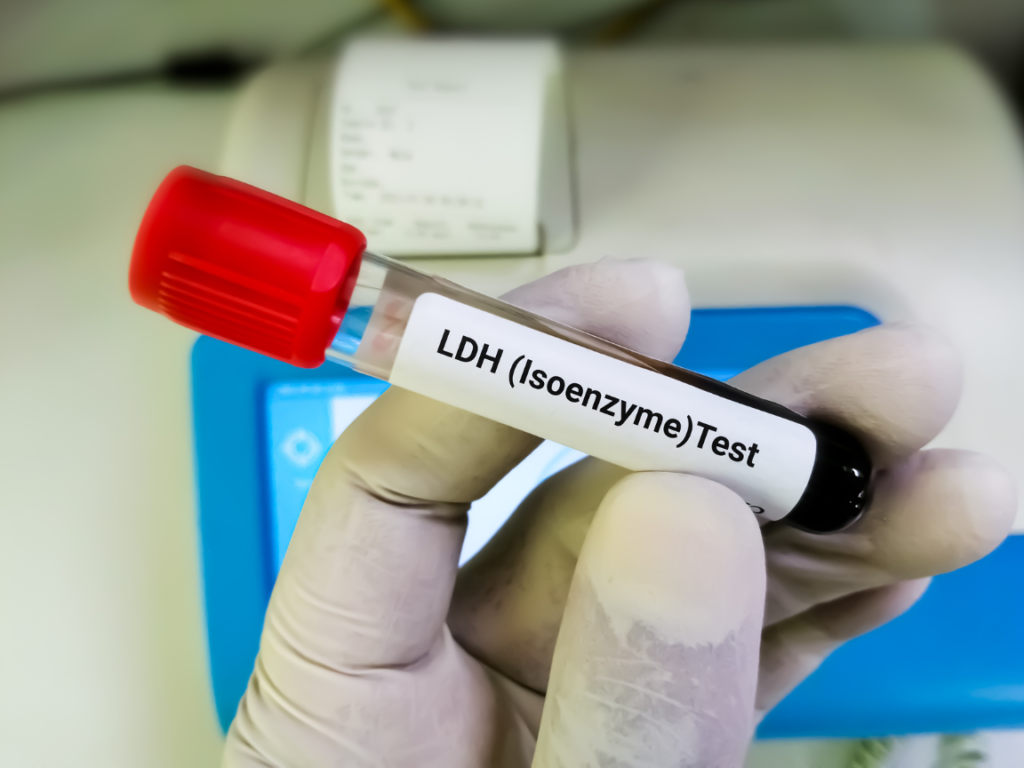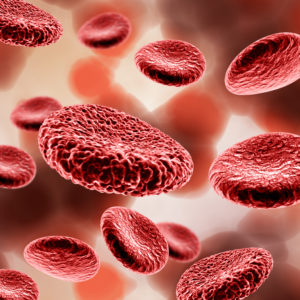Lactate dehydrogenase, which from now on we will refer to as LDH for shortness and ease of identification, is one of the hundreds of enzymes that we can find in the blood. Its levels are very well established and any irregularity can cause problems, whether it is upward or downward.
The analysis of these blood elements can help detect conditions that generate tissue damage or injury (liver or blood diseases) and monitor their progression. In fact, it can also be used to establish the stage of certain types of cancer, determine its prognosis or response to treatment and other functions that we will see throughout today’s post. We will look at normal values and when you can consider high and low LDH in comparison.
What is lactate dehydrogenase?
LDH, also known by the term we have used as lactic acid dehydrogenase, can be found in almost all tissues of the human body in addition to the blood. Its role is extremely important, although in reality we could never choose one component of the body over another, since each one fulfills a function that allows us to live a good and peaceful life. In this case, LDH is responsible for intervening in metabolic reactions that serve to obtain energy.
Hence its presence in almost the entire body, although it is the cells of the heart, liver, muscle, kidneys, lungs and blood that have the highest concentration. Its importance lies in the process it carries out in which the glucose from food is converted into the energy that the cells will use.
Levels of this enzyme can increase if tissue damage occurs due to injury or illness, in which case more LDH is released into the bloodstream. There are several diseases that can cause an increase in its levels (heart attacks, liver diseases, anemia, muscle trauma, bone fractures, cancer, meningitis, etc.), most of them related to the organs where it is most present. Later we will see in detail what they are.
An LDH analysis can help the doctor detect or rule out, along with irregular levels of the enzyme, a chronic disease. or acute that can cause cellular or tissue destruction, cancer, meningitis or if fluid has accumulated in any part of the body. It can also identify tissue injuries, but in these cases other tests will have to be performed to help determine where the damage is.
One of them is, for example, the analysis of LDH isoenzymes, in which the 5 types of LDH enzymes concentrated in different organs and tissues are studied. If blood levels are measured, health professionals will be able to more easily locate cellular damage, its type and severity. You will simply need a sample of venous blood or other fluids such as pleural fluid, peritoneal fluid, pericardial fluid or cerebrospinal fluid (CSF).
What is tested?
The purpose of the analysis of this enzyme is to measure its concentration to rule out possible damage or illness in a patient. Although the most common biological fluid to analyze its values is blood, it is not the only one:
In blood. It is in the serum or plasma of the blood, that is, in its liquid part, where we can find the amounts of LDH that it transports. They are usually small, but if cell or tissue damage or destruction occurs, the cells release more of this enzyme into the blood, so if we see high LDH, we will know that it is not a good sign.
In fact, it is usually used as a non-specific marker of cellular or tissue injury in any part of the body, but let us not forget that it does not only serve to identify the underlying cause or its exact location. That is why it is used in the evaluation or monitoring of disorders that cause tissue damage (liver diseases, blood diseases or cancer) along with other tests.
In biological fluids. When damage, inflammation or infection occurs in parts such as the brain, heart or lungs, fluid begins to accumulate or the normal composition of that same fluid is altered. If it is analyzed, we will be able to see its LDH concentration, which will help us determine the cause of the disorder. If, for example, a patient suffers from bacterial meningitis, LDH will have higher levels in the cerebrospinal fluid (CSF).
We have already mentioned it, but in the case of biological fluids, extra tests are also used to confirm whether the accumulated fluid, for example around the heart, lungs or in the abdominal cavity, is an exudate (due to tissue damage or inflammation). ) or a transudate (an alteration of the balance between pressure in the blood vessels and protein content in the blood).
How is it used?
As we have explained, it is very difficult for there to be a case in which the lactate dehydrogenase analysis allows us to determine a disease or problem accurately and without any doubt, but it can be useful in the evaluation of various disorders and diseases, such as in the following situations:
- As an indicator of acute or chronic tissue injury.
- To detect and monitor disorders such as anemia, including hemolytic and megaloblastic, or in severe infections.
- To determine the stage of certan types of cancer, its prognosis and help control its treatment (chemotherapy as in the case of germ cell tumors, lymphomas, leukemias, melanoma or neuroblastoma).
The LHD in body fluids can be determined:
- Evaluating cerebrospinal fluid (CSF) to distinguish viral from bacterial meningitis.
- In the evaluation of other body fluids (pleural, peritoneal or pericardial fluid), to determine if this detected accumulation is due to inflammatory causes, tissue injury (exudates) or some disorder in the balance between pressure in the blood vessels and the number of proteins in blood (transudates).
HWe must always remember that no analysis falls on deaf ears; any information you can provide us will be of vital importance to detectproblemand be able to start since minute with the most corrector treatment.
LDH values
Today we will look at LDH levels in adults only. Normal values range between 105 and 333 IU per liter of blood, but everything will depend on the laboratory in charge of the analysis, since it will be up to you to choose one type of medication or another or to analyze other types of samples. The doctor will always make decisions based on what they find, the patient’s medical history and their physical condition.
In the case of high LDH, it is difficult to immediately detect the cause of the irregularity, since this enzyme is present in a large part of our body. Therefore, we are going to see the possibilities divided into 3 aspects:
Blood-related causes of LDH. As this enzyme has a significant presence in red blood cells, an increase in it may mean that there has been a problem with this blood component. Hence, we usually think of hemolytic anemia, a disease in which red blood cells are destroyed earlier than normal. However, there are also other types of anemias that can reveal high LDH: those that lead to a deficiency of folic acid or vitamin B12. To rule out the hypothesis or continue with it, a vitamin analysis must be performed on the patient.
High LDH may have another cause: ischemia, a decrease, or in some cases stopping, of blood circulation through the arteries in a specific area of the body. This fact prevents the oxygen carried by the blood from reaching the organs or tissues that need it, causing cellular suffering.
Muscle-Related Causes of LDH. Moving on to muscular causes, we can find muscular dystrophy as the first on the list due to high LDH. This term refers to a group of more than 30 hereditary diseases that cause weakness and muscle loss. The way to treat it will depend on the severity of the pathology, although, as we always mention, a timely diagnosis can be vital to accelerate the healing process and stop the symptoms as much as possible.
Causes of LDH related to cancer. There are certain types of cancer that can generate high LDH. Its analysis will not only help us see if an increase has, in fact, been caused, but it will also help doctors know if the treatment that has been selected for the cancer patient is having an effect.
The cancer most associated with LDH is leukemia, characterized by excess white blood cells in the blood and bone marrow.
Causes of LDH in other parts of the body. Although those we have just discussed are the most common causes, we must also mention those that are related to different parts of the body or physical conditions:
- Having suffered a heart attack
- Liver diseases (hepatitis)
- Lung diseases
- Having suffered a stroke
- Pancreatitis
- Infectious mononucleosis
- Meningitis
- Muscle injury
- Tissue death
The causes of high LDH are varied, so it is best for a doctor to evaluate the situation and order the tests and exams you need to rule out origins and begin applying the most appropriate treatment. These analyzes are where the team comes in Ambar Lab, with a laboratory in which we offer more than 3,000 tests, support in the management of your business and the development of new projects.
We were born in 2012 from the will and desire of a group of professionals from different areas of biology, who after working together for more than 20 years in a reference laboratory, decided to create and develop our project; a modern company, with cutting-edge technology, extremely efficient and close. If you want to know more about the services we offer you can contact contactus so that we can manage together whatever you need.





